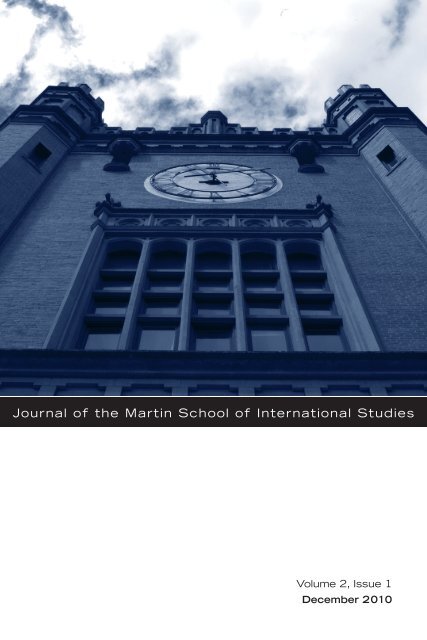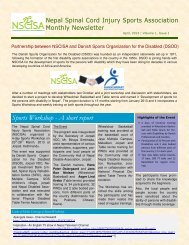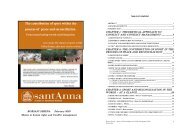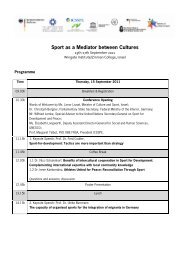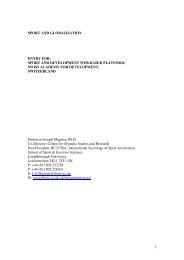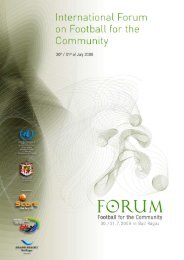Journal of the Martin School of International Studies
Journal of the Martin School of International Studies
Journal of the Martin School of International Studies
Create successful ePaper yourself
Turn your PDF publications into a flip-book with our unique Google optimized e-Paper software.
<strong>Journal</strong> <strong>of</strong> <strong>the</strong> <strong>Martin</strong> <strong>School</strong> <strong>of</strong> <strong>International</strong> <strong>Studies</strong><br />
Volume 2, Issue 1<br />
December 2010
<strong>Journal</strong> <strong>of</strong> <strong>the</strong><br />
MARTIN SCHOOL <strong>of</strong><br />
INTERNATIONAL STUDIES<br />
Volume 2, Issue 1<br />
Editors<br />
Connor Arbiter and Bonnie Magnuson<br />
<strong>Martin</strong> <strong>School</strong> Staff<br />
Bill L. Smith, Director<br />
Romuald K. Afatchao, Associate Director<br />
Kelli Schrand, Program Advisor<br />
Sandra Reineke, <strong>Martin</strong> Scholar Pr<strong>of</strong>essor<br />
<strong>Martin</strong> Institute Advisory Board<br />
Ka<strong>the</strong>rine Aiken<br />
Butch Alford<br />
Lisa Carlson<br />
John Chapman<br />
Raymond Dacey<br />
Verla Flores<br />
Sharlene Gage<br />
Holly Greenfield<br />
Joel Hamilton<br />
Morris Krigbaum<br />
Kevin <strong>Martin</strong><br />
Lowell <strong>Martin</strong><br />
Warren <strong>Martin</strong><br />
Sharon Scott<br />
George Simmons<br />
Richard Slaughter<br />
Gary Stubblefield<br />
Dirk van Beek<br />
Austin Warren<br />
Bob We<strong>the</strong>rell
4<br />
<strong>Journal</strong> <strong>of</strong> <strong>the</strong> <strong>Martin</strong> <strong>School</strong> <strong>of</strong> <strong>International</strong> <strong>Studies</strong>
Letter from <strong>the</strong> Editors<br />
Thirty years ago, Boyd A. <strong>Martin</strong> helped to found <strong>the</strong> <strong>Martin</strong> Institute at <strong>the</strong> University <strong>of</strong> Idaho to<br />
research <strong>the</strong> causes <strong>of</strong> international conflict and <strong>the</strong> conditions necessary for peace. Since that day, <strong>the</strong><br />
program that bears his name has worked daily to realize his dream by providing a forum for students <strong>of</strong><br />
international studies to meet both within and outside <strong>the</strong> classroom to discuss conflict, peace and security<br />
in <strong>the</strong> international system.<br />
Today, <strong>the</strong> <strong>Martin</strong> <strong>School</strong> <strong>of</strong> <strong>International</strong> <strong>Studies</strong> continues <strong>the</strong> legacy <strong>of</strong> its founder through a variety <strong>of</strong><br />
programs. Among <strong>the</strong>se programs are <strong>the</strong> Spotlight Seminars, where students are given <strong>the</strong> opportunity<br />
to engage with experts working in <strong>the</strong> field <strong>of</strong> international studies in an intimate and comfortable<br />
environment. The Institute and <strong>School</strong> also sponsor <strong>the</strong> <strong>Martin</strong> Scholar program, wherein a select group <strong>of</strong><br />
undergraduate students are given independent research opportunities to study a specific area <strong>of</strong> interest<br />
within a broad topic. Throughout <strong>the</strong> year, <strong>the</strong> Institute hosts several <strong>Martin</strong> Forums at which experts and<br />
pr<strong>of</strong>essionals in relevant fields speak to <strong>the</strong> students in a forum open to <strong>the</strong> entire university. Significantly,<br />
Boyd <strong>Martin</strong> was one <strong>of</strong> <strong>the</strong> original supporters <strong>of</strong> <strong>the</strong> annual Borah Symposium, which was inaugurated<br />
in 1938 and hosted First Lady Eleanor Roosevelt. With <strong>the</strong> continued assistance <strong>of</strong> <strong>the</strong> Institute, <strong>the</strong><br />
Symposium has since hosted many speakers who address issues related to <strong>the</strong> purpose <strong>of</strong> <strong>the</strong> <strong>Martin</strong><br />
Institute. Past keynote speakers for <strong>the</strong> Borah Symposium include Thurgood Marshall, Lech Walesa, F.W.<br />
de Klerk and Gro Harlem Brundtland.<br />
Last year, <strong>the</strong> <strong>Martin</strong> Institute published <strong>the</strong> first edition <strong>of</strong> its annual journal to provide a glimpse <strong>of</strong> what<br />
<strong>the</strong> <strong>Martin</strong> <strong>School</strong> <strong>of</strong> <strong>International</strong> <strong>Studies</strong> represents by exhibiting samples <strong>of</strong> <strong>the</strong> research and writing<br />
undertaken by its undergraduate students each year. This year, we <strong>the</strong> editors are proud to present to you<br />
<strong>the</strong> second volume <strong>of</strong> <strong>the</strong> <strong>Martin</strong> <strong>Journal</strong>. The articles included are chosen from among <strong>the</strong> best papers <strong>of</strong><br />
<strong>the</strong> spring 2010 senior capstone course, in which students wrote policy recommendations in <strong>the</strong> general<br />
area <strong>of</strong> transboundary issues, and among <strong>the</strong> <strong>Martin</strong> Scholar papers, researched according to <strong>the</strong> <strong>the</strong>me<br />
<strong>of</strong> “Genes and Justice: Biotechnology and Biomedical Policy Formation in a Global Perspective.” These<br />
papers were selected to show <strong>the</strong> breadth and depth <strong>of</strong> study in which <strong>Martin</strong> Institute students engage.<br />
Additionally, we have included <strong>the</strong> transcript <strong>of</strong> our interview with former British Ambassador to Peru and<br />
Brazil Keith Haskell, who spoke at a <strong>Martin</strong> Forum in early October 2010 at <strong>the</strong> University <strong>of</strong> Idaho.<br />
We sincerely hope that you are able to enjoy <strong>the</strong>se works as much as we have and take away new knowledge<br />
about <strong>the</strong> efforts necessary to establish and maintain peace in <strong>the</strong> world.<br />
Respectfully,<br />
S. Connor Arbiter Bonnie Magnuson<br />
Senior Senior<br />
<strong>International</strong> <strong>Studies</strong> and French <strong>International</strong> <strong>Studies</strong>, French and Economics<br />
Vol. 2, Issue 1 December 2010 5
6<br />
It now becomes necessary for us to put our major global problems<br />
into a socially relevant global framework.<br />
Our world has become too complex, too interdependent,<br />
to answer <strong>the</strong>se questions by simplistic answers.<br />
These problems call for creative thinking...<br />
– Boyd A. <strong>Martin</strong>, founder <strong>of</strong> <strong>the</strong> <strong>Martin</strong> Institute and namesake<br />
<strong>of</strong> <strong>the</strong> <strong>Martin</strong> <strong>School</strong> <strong>of</strong> <strong>International</strong> <strong>Studies</strong>, at <strong>the</strong><br />
Institute’s inauguration, 1980<br />
<strong>Journal</strong> <strong>of</strong> <strong>the</strong> <strong>Martin</strong> <strong>School</strong> <strong>of</strong> <strong>International</strong> <strong>Studies</strong>
3 Letter from <strong>the</strong> Editors<br />
6 Sport for Development and Peace<br />
Chad Mann<br />
Table <strong>of</strong> Contents<br />
16 The Counterterrorism and Counterinsurgency Complex<br />
Nicholas C. Castle<br />
24 Seeking Asylum in Europe<br />
Josh Hickey<br />
30 Child Trafficking through Latin America<br />
Elisa M. Briesmeister<br />
36 Promoting Sustainable Agriculture in <strong>the</strong> Baltic States<br />
Alexis Olson<br />
42 Global Infectious Disease and U.S. National Security<br />
Lynn McAlister<br />
48 Interview with Ambassador Keith Haskell<br />
2010<br />
<strong>Journal</strong> <strong>of</strong> <strong>the</strong> <strong>Martin</strong> <strong>School</strong><br />
<strong>of</strong> <strong>International</strong> <strong>Studies</strong><br />
Vol. 2, Issue 1 December 2010 7
8<br />
Background<br />
Sport for<br />
Developement<br />
and Peace<br />
Achieving <strong>the</strong> Millennium<br />
Development Goals<br />
through Sports-Based<br />
Initiatives<br />
– Chad Mann<br />
In <strong>the</strong> modern international system, <strong>the</strong> regions<br />
<strong>of</strong> <strong>the</strong> world have become increasingly integrated<br />
and connected through an ever-expanding network<br />
<strong>of</strong> communications and trade. As this rate <strong>of</strong><br />
globalization continues to grow, <strong>the</strong> need to deal<br />
with global problems has become a primary focus<br />
for <strong>the</strong> international community. In September<br />
2000, all <strong>of</strong> <strong>the</strong> world’s countries and major<br />
development groups signed <strong>the</strong> United Nations<br />
(UN) Millennium Declaration. 1 This document<br />
focused on <strong>the</strong> poorest nations <strong>of</strong> <strong>the</strong> world and<br />
<strong>the</strong> most pressing obstacles to development within<br />
<strong>the</strong>m. The declaration set up <strong>the</strong> Millennium<br />
Development Goals (MDGs), targets to overcoming<br />
obstacles ranging from poverty eradication to<br />
environmental protection and including everything<br />
in between. These goals were set to be achieved<br />
by <strong>the</strong> year 2015; however, with only five years<br />
left to attain <strong>the</strong>m, efforts must be increased.<br />
The downturn <strong>of</strong> <strong>the</strong> global economy in <strong>the</strong> latter<br />
part <strong>of</strong> <strong>the</strong> past decade created a major roadblock<br />
to success with <strong>the</strong> MDGs, and much progress<br />
has ei<strong>the</strong>r stalled or been reversed. 2 When world<br />
leaders convene during <strong>the</strong> 20-22 September 2010<br />
Summit on <strong>the</strong> Millennium Development Goals to<br />
review progress, a new, diverse strategy must be<br />
implemented in order to achieve success in global<br />
development.<br />
As globalization has increased, so too has <strong>the</strong><br />
recognition <strong>of</strong> <strong>the</strong> positive role sport can play<br />
in peace and development. The power <strong>of</strong> sport<br />
was discovered as far back as 776 BC, with <strong>the</strong><br />
first recorded Olympic Games but is most likely<br />
much older than that. 3 Its ability to mobilize, both<br />
positively and negatively, cannot be ignored. On<br />
Christmas Day 1914, German and British WWI<br />
troops agreed to a one day “football truce,” in which<br />
both sides suspended fighting to engage in football<br />
games and camaraderie. 4 In 1972, eleven Israeli<br />
athletes were murdered at <strong>the</strong> Munich Olympic<br />
Games by Palestinian terrorists. Historically, sport<br />
has had a major impact on international relations.<br />
In more modern times, <strong>the</strong> Sport for Development<br />
and Peace agenda gained significant momentum<br />
in 2001 when former UN Secretary-General K<strong>of</strong>i<br />
Annan appointed former President <strong>of</strong> <strong>the</strong> Swiss<br />
Confederation Adolf Ogi as his Special Adviser on<br />
1 “A/res/55/2.” Welcome to <strong>the</strong> United Nations: It's Your<br />
World. 08 Sept. 2000. Web. 06 May 2010. .<br />
2 United Nations. The Millennium Development Goals<br />
Report 2009. New York: United Nations, 2009.<br />
3 “Ancient Olympics FAQ 11.” Perseus Digital<br />
Library. Web. 07 Apr. 2010. .<br />
4 “BBC NEWS | UK | 1914 ‘football Truce’<br />
Anniversary.” BBC NEWS | News Front Page.<br />
24 Dec. 2004. Web. 07 Apr. 2010. .<br />
<strong>Journal</strong> <strong>of</strong> <strong>the</strong> <strong>Martin</strong> <strong>School</strong> <strong>of</strong> <strong>International</strong> <strong>Studies</strong>
Sport for Development and Peace. In July 2002,<br />
Annan convened <strong>the</strong> UN Inter-Agency Task Force<br />
on Sport for Development and Peace to review<br />
activities involving sport within <strong>the</strong> UN system. 5<br />
In October 2003, <strong>the</strong> Secretary-General published<br />
<strong>the</strong> report <strong>of</strong> <strong>the</strong> Task Force entitled “Sport for<br />
Development and Peace: Towards Achieving <strong>the</strong><br />
MDGs.” This report laid <strong>the</strong> foundation for <strong>the</strong><br />
adoption <strong>of</strong> UN Resolution 58/5 on 3 November<br />
2003. The resolution proclaimed 2005 as <strong>the</strong><br />
<strong>International</strong> Year <strong>of</strong> Sport and Physical Education<br />
(IYSPE), in which governments, <strong>the</strong> private sector,<br />
civil society, <strong>the</strong> UN and all o<strong>the</strong>r relevant actors<br />
were called upon to fully research ways to integrate<br />
sport into <strong>the</strong>ir various programs and share <strong>the</strong>ir<br />
findings with <strong>the</strong> international community. 6 While<br />
<strong>the</strong> IYSPE was considered a success, <strong>the</strong> momentum<br />
gained during <strong>the</strong> year must be sustained.<br />
Harnessing <strong>the</strong> benefits <strong>of</strong> sport can increase global<br />
development success. Following is a detailed list <strong>of</strong><br />
solutions and policy recommendations aimed at<br />
taking advantage <strong>of</strong> <strong>the</strong> power <strong>of</strong> sport to achieve<br />
success within each <strong>of</strong> <strong>the</strong> MDGs.<br />
MDG #1: Eradicate Extreme Poverty<br />
and Hunger<br />
The Economic Impact <strong>of</strong> Hosting Sporting<br />
Events<br />
MDG #1 strives to eradicate extreme poverty<br />
and hunger in part by confronting issues related<br />
to acceptable employment and wage levels. The<br />
2008 Beijing Olympic Games supported this goal<br />
in that <strong>the</strong> 19.49 billion yuan (US $2.9 billion)<br />
invested in <strong>the</strong> construction <strong>of</strong> 102 Olympic<br />
projects, in combination with <strong>the</strong> 19.343 billion<br />
yuan (US $2.9 billion) operating cost, created an<br />
astounding amount <strong>of</strong> employment opportunities<br />
for Chinese laborers. 7 Applying for host positions<br />
5 “Our Mandate - What Does Sport Have to Do with <strong>the</strong><br />
UN.” Welcome to <strong>the</strong> United Nations: It's Your World.<br />
Web. 07 Apr. 2010.<br />
.<br />
6 Report on <strong>the</strong> <strong>International</strong> Year <strong>of</strong> Sport and<br />
Physical Education: Sport for a Better World.<br />
(Geneva: United Nations, 2005) 386.<br />
7 “Beijing Olympics Generated China a Pr<strong>of</strong>it <strong>of</strong> 146<br />
Million Dollars.” Thaindian News. 20 June 2009.<br />
Web. 07 Apr. 2010. .<br />
for <strong>the</strong> Francophone Games (reserved for members<br />
<strong>of</strong> <strong>the</strong> Francophone world), Commonwealth<br />
Games (restricted to former members <strong>of</strong> <strong>the</strong> British<br />
Empire) or U-17/U-20 Fédération <strong>International</strong>e<br />
de Football Association (FIFA) World Cups can<br />
lead to opportunities for access to aid from <strong>the</strong><br />
governing bodies <strong>of</strong> <strong>the</strong>se tournaments in <strong>the</strong> form<br />
<strong>of</strong> stadium renovations, information technology<br />
upgrades and infrastructure improvement and<br />
<strong>the</strong> implementation <strong>of</strong> sports education and<br />
community outreach programs. These smaller yet<br />
internationally renowned tournaments generally<br />
take place in less developed areas <strong>of</strong> <strong>the</strong> world, like<br />
Francophone venues in Madagascar and Lebanon<br />
or Commonwealth Games events in Malaysia and<br />
Jamaica. In 2009, FIFA spent US $172 million on<br />
development projects for countries hosting FIFArelated<br />
events. With an additional US $800 million<br />
allocated for development between 2011 and 2014,<br />
it is imperative for developing countries to apply for<br />
event host positions. 8<br />
The Role <strong>of</strong> <strong>the</strong> Sports Industry<br />
As <strong>the</strong> 2005 IYSPE report stated, <strong>the</strong> sports<br />
industry can play a principal role in obtaining<br />
MDG #1. While <strong>the</strong>ir impact is not always seen<br />
as positive, <strong>the</strong> fact remains that sporting goods<br />
manufacturers have an immense say in <strong>the</strong><br />
policies and economic policies <strong>of</strong> developing<br />
countries. NIKE, Inc. employs over 800,000<br />
workers in 46 countries worldwide. 9 The adidas<br />
Group, a corporation consisting <strong>of</strong> sporting goods<br />
giants adidas, Reebok and TaylorMade, utilizes<br />
over 40,000 employees in 55 countries. 10 Both<br />
NIKE, Inc. and <strong>the</strong> adidas Group work with local<br />
governments in setting wage rates and benefits<br />
plans. As mandated in <strong>the</strong> corporations’ charters,<br />
all workers must receive no less than <strong>the</strong> locally<br />
accepted minimum wage. Along with determining<br />
8 FIFA Financial Report 2009. Rep. 60th FIFA<br />
Congress, 10 June 2009. Web. 9 May 2010.<br />
.<br />
9 “3.1 Overview - NIKE, Inc.” Nikebiz : NIKE,<br />
Inc. Official Site, <strong>the</strong> World’s Largest, Leading<br />
Athletic Brand. Web. 07 Apr. 2010. .<br />
10 “Overview.” Company Overview. adidas Group.<br />
Web. 12 May 2010. .<br />
Vol. 2, Issue 1 December 2010 9
10<br />
wages, corporations have a substantial impact<br />
on <strong>the</strong> communities within which <strong>the</strong>y operate.<br />
For example, <strong>the</strong> adidas Group’s Education and<br />
Infrastructure Program with <strong>the</strong> non-governmental<br />
organization (NGO) Sudhaar in Pakistan works to<br />
increase access to education and prevent <strong>the</strong> use<br />
<strong>of</strong> child labor for youth living around <strong>the</strong> football<br />
stitching factory in Sialkot. 11 Governments, along<br />
with local trade unions and NGOs in many<br />
countries, have shown <strong>the</strong>ir willingness to develop<br />
strong working partnerships with corporations<br />
like NIKE, Inc. and <strong>the</strong> adidas Group in order to<br />
ensure proper social and working conditions in<br />
combination with adequate compensation for <strong>the</strong>ir<br />
citizens. These large, multinational corporations<br />
are vital to making sure that <strong>the</strong> number <strong>of</strong> people<br />
living in poverty or employed for less than US $1<br />
per day will decrease in <strong>the</strong> future.<br />
MDG #2: Achieve Universal Primary<br />
Education<br />
Continued Funding for Physical Education<br />
Programs<br />
MDG #2 works to increase literacy rates and<br />
educational access so that all children, both boys<br />
and girls, will have <strong>the</strong> ability to complete an entire<br />
course <strong>of</strong> primary education. 12 The IYSPE 2005<br />
Report states that “sport and physical education<br />
are essential elements <strong>of</strong> a quality education” and<br />
that <strong>the</strong>y “generally make school more attractive<br />
and improve attendance.” 13 Policymakers at all<br />
levels must be aware <strong>of</strong> this fact and account for<br />
<strong>the</strong> benefits that physical education and sport<br />
have when constructing educational budgets. As<br />
is stated in <strong>the</strong> 10 December 1959 UN Declaration<br />
<strong>of</strong> <strong>the</strong> Rights <strong>of</strong> <strong>the</strong> Child, “<strong>the</strong> child shall have full<br />
opportunity for play and recreation, which should<br />
be directed to <strong>the</strong> same purposes as education;<br />
11 “Case <strong>Studies</strong>.” adidas Group, 23 Nov. 2009.<br />
Web. 09 May 2010. .<br />
12 “MDG MONITOR :: Goal :: Achieve Universal<br />
Primary Education.” MDG MONITOR :: Tracking<br />
<strong>the</strong> Millennium Development Goals. Web. 07 Apr.<br />
2010. .<br />
13 Report on <strong>the</strong> <strong>International</strong> Year <strong>of</strong> Sport and<br />
Physical Education: Sport for a Better World.<br />
(Geneva: United Nations, 2005) 386.<br />
society and <strong>the</strong> public authorities shall endeavour<br />
to promote <strong>the</strong> enjoyment <strong>of</strong> this right.” 14 Financial<br />
cuts to physical education programs must be<br />
seen as a last resort. Physical education is <strong>of</strong><br />
immeasurable importance to fur<strong>the</strong>r success in<br />
school. The highest levels <strong>of</strong> progress and success<br />
in o<strong>the</strong>r educational subjects such as reading,<br />
math and science are much more difficult to<br />
attain without incorporating some type <strong>of</strong> physical<br />
activity into curriculums. Financial support to<br />
any form <strong>of</strong> youth physical education/recreation<br />
program is vital to achieving MDG #2.<br />
Educating Community Leaders as Sports<br />
Advocates and Ambassadors<br />
In fur<strong>the</strong>r efforts to promote <strong>the</strong> use <strong>of</strong> sports<br />
in primary education, programs aimed at educating<br />
adults to become community leaders and<br />
promoters <strong>of</strong> youth recreation can be incredibly<br />
helpful. The Dutch organization <strong>of</strong> sports physicians<br />
and physio<strong>the</strong>rapists known as Koninklijke<br />
Nederlandse Voetbalbond (KNVB) has created <strong>the</strong><br />
“Coach-<strong>the</strong>-Coach Programme.” 15 In <strong>the</strong> program,<br />
local partner organizations/groups request <strong>the</strong><br />
services <strong>of</strong> KNVB instructors. If approved, KNVB<br />
personnel travel to <strong>the</strong> community and spend two<br />
or more weeks training adults in basic courses about<br />
football <strong>the</strong>ory and practice techniques. Along with<br />
<strong>the</strong> sports-based instruction, community leaders<br />
also receive training on how to serve as positive<br />
role models for community youth and prepare<br />
<strong>the</strong>m to be successful in life beyond sports. The<br />
Canadian-based NGO Right to Play incorporates<br />
similar techniques by educating community<br />
“Leaders” to serve as trainers and advocates in<br />
<strong>the</strong> field <strong>of</strong> development and sport. Thanks to <strong>the</strong><br />
efforts <strong>of</strong> Right to Play, over one million children<br />
in <strong>the</strong> developing world are able to attend regular<br />
sporting events and programs. 16 These locallybased,<br />
bottom-up programs have proven to be very<br />
14 “Universal Declaration <strong>of</strong> Human Rights.” Welcome<br />
to <strong>the</strong> United Nations: It's Your World. 10 Dec.<br />
1959. Web. 07 Apr. 2010. .<br />
15 “Coach <strong>the</strong> Coach.” Toolkit Sport for<br />
Development. Web. 07 Apr. 2010. .<br />
16 “At a Glance.” Right to Play. Web. 07 Apr. 2010.<br />
.<br />
<strong>Journal</strong> <strong>of</strong> <strong>the</strong> <strong>Martin</strong> <strong>School</strong> <strong>of</strong> <strong>International</strong> <strong>Studies</strong>
successful within developing areas, fur<strong>the</strong>r helping<br />
to achieve MDG #2.<br />
MDG #3: Promote Gender Equality &<br />
Empower Women<br />
Youth-Based Sporting Events Focused on<br />
Gender Integration<br />
MDG #3 directs attention to <strong>the</strong> effort <strong>of</strong><br />
completely erasing any inequalities between<br />
genders at all education levels and also works to<br />
increase both <strong>the</strong> number <strong>of</strong> women working in <strong>the</strong><br />
non-agricultural sector and <strong>the</strong> number <strong>of</strong> positions<br />
held by women in national parliaments. 17 Sport<br />
serves as a way for females to “build confidence<br />
and stronger social integration.” 18 Increasing<br />
access to sporting/recreation opportunities for<br />
girls alongside boys can serve as an effective way<br />
to reduce or eliminate gender-based prejudices<br />
and discriminations at an early age. Events such<br />
as PLAY SOCCER’s Global Peace Games work to<br />
organize sporting events around <strong>the</strong> world that<br />
appeal equally to both boys and girls. Since 2001,<br />
participation in <strong>the</strong>se Global Peace Games has<br />
steadily risen, as has <strong>the</strong> level <strong>of</strong> participation<br />
for girls. However, much remains to be done to<br />
fully gain gender equality. Of <strong>the</strong> 13,334 children<br />
participating in <strong>the</strong> seven PLAY SOCCER country<br />
organizations in 2009, nearly 64%, or 8,446<br />
participants, were males. South Africa has had<br />
<strong>the</strong> most success in attaining equality, with over<br />
40% <strong>of</strong> participants being female. 19 Following<br />
<strong>the</strong> standards set by <strong>the</strong> South African program,<br />
countries can work to improve <strong>the</strong>ir own gender<br />
issues through sporting events.<br />
Sport and Inclusion for All<br />
Not only does sport serve as a way to include<br />
women alongside men, it is also <strong>the</strong> perfect<br />
medium for incorporating and connecting people<br />
living in disadvantageous situations or with various<br />
17 “MDG MONITOR :: Goal :: Promote Gender Equality<br />
and Empower Women.” MDG MONITOR :: Tracking<br />
<strong>the</strong> Millennium Development Goals. Web. 07 Apr.<br />
2010. .<br />
18 Report on <strong>the</strong> <strong>International</strong> Year <strong>of</strong> Sport and<br />
Physical Education: Sport for a Better World.<br />
(Geneva: United Nations, 2005) 386.<br />
19 “Global Peace Games.” Play Soccer Nonpr<strong>of</strong>it<br />
<strong>International</strong>. Web. 07 Apr. 2010. .<br />
disabilities. Events similar to those organized by<br />
<strong>the</strong> Special Olympics and Paralympics are excellent<br />
examples <strong>of</strong> this both on an international and local<br />
level. The continued, localized efforts <strong>of</strong> lesser<br />
known groups around <strong>the</strong> world also serve as a<br />
way to include disabled or disadvantaged people.<br />
In Ethiopia, <strong>the</strong> 2005 “Sport for All” program<br />
mobilized over 400,000 students to take part in<br />
different sporting events and awareness seminars.<br />
The program brought toge<strong>the</strong>r 33 physical<br />
education teachers from around <strong>the</strong> country to<br />
attend workshops in which different strategies<br />
to include disabled people in physical education<br />
were discussed. 20 The Homeless World Cup, an<br />
annual street football tournament, brings groups<br />
<strong>of</strong> homeless teams toge<strong>the</strong>r from around <strong>the</strong><br />
world to compete and raise awareness about <strong>the</strong>ir<br />
living situations, while <strong>the</strong> UN High Commissioner<br />
for Refugees (UNHCR) organizes various sports<br />
programs like Kenya’s “Toge<strong>the</strong>r for Girls” in order<br />
to positively affect youth in refugee situations. 21<br />
Drawing from <strong>the</strong> international recognition <strong>of</strong><br />
organizations like <strong>the</strong> Special Olympics or UNHCR<br />
and <strong>the</strong> vast amount <strong>of</strong> resources and information<br />
available through <strong>the</strong>m, smaller groups have found<br />
success with a more detailed, region-specific<br />
approach to inclusion, both <strong>of</strong> women and disabled<br />
or disadvantaged people.<br />
MDGs #4 & #5: Reduce Child Mortality<br />
& Improve Maternal Health<br />
Increased Access to Information Regarding<br />
Childbirth and Maternity<br />
MDGs #4 and #5 are intrinsically connected.<br />
Targets to reduce both infant and maternal<br />
mortality rates are primarily based upon <strong>the</strong><br />
education <strong>of</strong> women prior to pregnancy. As sports<br />
work to empower women, <strong>the</strong>y also provide<br />
women with access to resources and information<br />
about maternity and family planning programs.<br />
Africa-based NGO Hoops 4 Hope (H4H) provides<br />
a perfect example. H4H works to build basketball<br />
20 Report on <strong>the</strong> <strong>International</strong> Year <strong>of</strong> Sport and<br />
Physical Education: Sport for a Better World.<br />
(Geneva: United Nations, 2005) 386.<br />
21 Report on <strong>the</strong> <strong>International</strong> Year <strong>of</strong> Sport and<br />
Physical Education: Sport for a Better World.<br />
(Geneva: United Nations, 2005) 285.<br />
Vol. 2, Issue 1 December 2010 11
12<br />
courts, supply sporting equipment and organize<br />
leagues and clinics for youth in Zimbabwe and<br />
South Africa. 22 H4H uses its “Skills 4 Life” program<br />
to educate participants on healthy lifestyle<br />
choices in poverty-ridden areas. This program<br />
primarily focuses on providing youth aged 18-<br />
24 with information promoting abstinence, safe<br />
sex, condom use and distribution, counseling<br />
and medical treatment. 23 Along with education,<br />
increased access to physical/recreational<br />
opportunities for expecting mo<strong>the</strong>rs significantly<br />
reduces <strong>the</strong> likelihood <strong>of</strong> infants being born with<br />
critical health problems. According to <strong>the</strong> 2002<br />
World Health Organization’s (WHO) World Health<br />
Report, more people worldwide were classified<br />
as overweight or obese (1 billion) than hungry<br />
(800 million). 24 Overweight or obese mo<strong>the</strong>rs put<br />
<strong>the</strong>ir children at a much higher risk for developing<br />
weight-related health problems later on in life.<br />
Programs designed to incorporate women,<br />
especially expecting mo<strong>the</strong>rs, into physical<br />
activities can dramatically decrease this risk.<br />
Using Sports to Connect with Normally<br />
Inaccessible Populations<br />
One <strong>of</strong> <strong>the</strong> most important targets <strong>of</strong> MDG<br />
#4 is to provide all youth with vital medical care<br />
within <strong>the</strong> first few years <strong>of</strong> <strong>the</strong>ir life. In developing<br />
countries, children most in need <strong>of</strong> immunizations,<br />
vaccines and o<strong>the</strong>r forms <strong>of</strong> early childhood care<br />
are usually <strong>the</strong> hardest for medical pr<strong>of</strong>essionals<br />
to reach. Promoting various sporting activities in<br />
order to contact <strong>the</strong>se children and provide <strong>the</strong>m<br />
with <strong>the</strong> necessary basic services to lead a healthy<br />
childhood has proven very effective. In <strong>the</strong> WHO:<br />
Europe Report on <strong>the</strong> European Immunization<br />
Week, local sporting events were identified as key<br />
avenues through which to distribute informational<br />
material to parents about <strong>the</strong> need for certain<br />
22 “What H4H Does.” Welcome to Hoops 4 Hope: What<br />
We Do. Hoops 4 Hope. Web. 09 May 2010. .<br />
23 Report on <strong>the</strong> <strong>International</strong> Year <strong>of</strong> Sport and<br />
Physical Education: Sport for a Better World.<br />
(Geneva: United Nations, 2005) 346.<br />
24 “WHO | Chapter 3.” World Health Report.<br />
Web. 07 Apr. 2002. .<br />
medical attention for <strong>the</strong>ir children. 25 Similar<br />
conclusions were drawn by <strong>the</strong> Republic <strong>of</strong> Yemen’s<br />
Ministry <strong>of</strong> Public Health and Population from<br />
<strong>the</strong> Eastern Mediterranean Region’s Vaccination<br />
Week. The Ministry recognized sporting events<br />
as helpful tools to increase advocacy, education<br />
and communication with its population about<br />
preventable diseases. 26 Sports serve as a way to<br />
connect those kids in need with available help.<br />
MDG #6: Combat HIV/AIDS, Malaria &<br />
O<strong>the</strong>r Diseases<br />
Utilizing Sporting Events as Social Awareness<br />
Platforms<br />
In <strong>the</strong> fight to halt <strong>the</strong> spread <strong>of</strong> <strong>the</strong>se deadly<br />
diseases and achieve MDG #6, sport can effectively<br />
be used as a form <strong>of</strong> social awareness. In 2004 and<br />
2005, <strong>the</strong> Joint United Nations Programme on<br />
HIV/AIDS joined with <strong>the</strong> <strong>International</strong> Olympic<br />
Committee and <strong>the</strong> <strong>International</strong> Cricket Council,<br />
respectively, in agreements to use <strong>the</strong> sporting<br />
events set up by those organizations as awareness<br />
platforms. 27 Increased cooperation between health<br />
and sports related groups will fur<strong>the</strong>r help to<br />
combat <strong>the</strong>se diseases. This has effectively been<br />
used at all levels <strong>of</strong> development. According to <strong>the</strong><br />
IYSPE 2005 Report, “sport can help reach out to<br />
o<strong>the</strong>rwise distanced and marginalized populations<br />
and provide positive role models delivering<br />
prevention messages.” 28<br />
A perfect example <strong>of</strong> this can be seen in Kenya,<br />
where 1700 residents <strong>of</strong> Kwale participated in a<br />
full-day football tournament, “Kick AIDS Out <strong>of</strong><br />
Kwale,” designed to promote <strong>the</strong> empowerment<br />
25 European Immunization Week: Lessons Learnt and Next<br />
Steps. Rep. World Health Organization: Europe, 20<br />
Sept. 2006. Web. 9 May 2010. .<br />
26 Draft Country Work Plan for <strong>the</strong> Implementation <strong>of</strong><br />
<strong>the</strong> 2010. Rep. Republic <strong>of</strong> Yemen: Ministry <strong>of</strong> Public<br />
Health & Population. Web. 9 May 2010. .<br />
27 Report on <strong>the</strong> <strong>International</strong> Year <strong>of</strong> Sport and<br />
Physical Education: Sport for a Better World.<br />
(Geneva: United Nations, 2005) 386.<br />
28 Report on <strong>the</strong> <strong>International</strong> Year <strong>of</strong> Sport and<br />
Physical Education: Sport for a Better World.<br />
(Geneva: United Nations, 2005) 386.<br />
<strong>Journal</strong> <strong>of</strong> <strong>the</strong> <strong>Martin</strong> <strong>School</strong> <strong>of</strong> <strong>International</strong> <strong>Studies</strong>
<strong>of</strong> girls and to increase HIV/AIDS awareness. 29<br />
Right to Play’s “SportHealth” program works in<br />
partnership with local organizations to increase <strong>the</strong><br />
ability <strong>of</strong> local groups to use sports to positively<br />
affect youth. Right to Play trains local community<br />
members on both physical education opportunities<br />
and HIV/AIDS prevention measures. 30 With this<br />
training, community members are able to actively<br />
engage local youth by combining <strong>the</strong> entertaining<br />
aspects <strong>of</strong> recreation with <strong>the</strong> educational aspects<br />
<strong>of</strong> disease awareness. These programs serve as<br />
powerful tools in <strong>the</strong> effort to eradicate fatal<br />
diseases.<br />
Improving Health through <strong>the</strong> General Global<br />
Popularity <strong>of</strong> Sport<br />
In addition to actual sporting events, <strong>the</strong><br />
worldwide following <strong>of</strong> sports can be harnessed<br />
to fur<strong>the</strong>r advance efforts to eradicate deadly<br />
diseases like malaria. Different forms <strong>of</strong> media can<br />
serve as strong proponents for taking action. In a<br />
2006 column for <strong>the</strong> popular magazine, Sports<br />
Illustrated, entitled “Nothing but Nets,” Rick Reilly<br />
brought <strong>the</strong> devastating issue <strong>of</strong> malaria to <strong>the</strong><br />
forefront <strong>of</strong> sports fan consciousness. He challenged<br />
his readers to donate US $10 towards buying antimalaria<br />
bed nets for needy people in Africa. 31<br />
Building on <strong>the</strong> momentum created by Reilly’s<br />
readers, <strong>the</strong> UN Foundation launched <strong>the</strong> “Nothing<br />
but Nets” campaign in 2006. In partnership<br />
with Sports Illustrated, <strong>the</strong> National Basketball<br />
Association’s NBA Cares and Major League Soccer’s<br />
MLS W.O.R.K.S, <strong>the</strong> UN Foundation has made<br />
<strong>the</strong> goal <strong>of</strong> ending malaria by 2015 appear very<br />
realistic. NBA Cares, during <strong>the</strong> 2009 NBA Season<br />
<strong>of</strong> Giving, gave away two complimentary tickets<br />
to NBA games for each $10 donation to Nothing<br />
but Nets. MLS W.O.R.K.S. engaged teams and fans<br />
in <strong>the</strong> global fight against malaria, while Women’s<br />
NBA star Ruth Riley fur<strong>the</strong>red <strong>the</strong> campaign with<br />
29 Berna, Alison Q. “UNICEF's Programme in Sports<br />
for Development.” UNICEF (2004). Web.<br />
30 “At a Glance.” Right to Play. Web. 07 Apr. 2010.<br />
.<br />
31 NothingButNets.net: 2009 Annual Report. Rep.<br />
United Nations Foundation. Web. 11 May 2010.<br />
.<br />
awareness events throughout Spain. 32 Using <strong>the</strong><br />
loyal following <strong>of</strong> sports fans around <strong>the</strong> world can<br />
aid policymakers in achieving <strong>the</strong> MDGs.<br />
Goal 7: Ensure Environmental<br />
Sustainability<br />
Effectively Connecting Youth Sports with<br />
Environment Protection<br />
Environmental sustainability has been <strong>of</strong><br />
utmost importance in <strong>the</strong> latter half <strong>of</strong> <strong>the</strong> past<br />
century. MDG #7 works to implement sustainable<br />
development and stop environmental loss. 33<br />
The IYSPE 2005 Report explains “Sport is an<br />
ideal tool to raise awareness about <strong>the</strong> need to<br />
preserve <strong>the</strong> environment and <strong>the</strong> importance <strong>of</strong><br />
environmental sustainability when hosting sports<br />
events. The interdependence between <strong>the</strong> regular<br />
practice <strong>of</strong> outdoor sports and <strong>the</strong> protection <strong>of</strong><br />
<strong>the</strong> environment are obvious for all to realize.” 34<br />
The UN Environmental Programme (UNEP) has<br />
taken <strong>the</strong> targets <strong>of</strong> this goal and combined <strong>the</strong>m<br />
with <strong>the</strong> benefits <strong>of</strong> sport in its Nature and Sport<br />
Training Camps. In partnership with <strong>the</strong> Global<br />
Sports Alliance (GSA), UNEP works to provide<br />
youth in developing areas <strong>of</strong> Africa, Asia and <strong>the</strong><br />
Pacific, Latin America and <strong>the</strong> Caribbean with<br />
quality leadership training over issues relating to<br />
culture, sport and <strong>the</strong> environment. The inaugural<br />
camp is in Nairobi, Kenya, and has <strong>the</strong> potential<br />
to educate over 30,000 children annually about<br />
issues such as recycling and community cleanups,<br />
along with sport-based instruction. 35 As <strong>the</strong><br />
camp continues to evolve, financial aid is needed to<br />
sustain its activities along with <strong>the</strong> UNEP’s plans to<br />
set up more camps globally. This program provides a<br />
creative way to combine sports with environmental<br />
32 NothingButNets.net: 2009 Annual Report.<br />
11 May 2010. .<br />
33 “MDG MONITOR :: Goal :: Ensure Environmental<br />
Sustainability.” MDG MONITOR :: Tracking <strong>the</strong><br />
Millennium Development Goals. Web. 07 Apr.<br />
2010. .<br />
34 Report on <strong>the</strong> <strong>International</strong> Year <strong>of</strong> Sport and<br />
Physical Education: Sport for a Better World.<br />
(Geneva: United Nations, 2005) 386.<br />
35 “Nature and Sports Training Camps. – United<br />
Nations Environment Programme (UNEP) - Home<br />
Page –. Web. 07 Apr. 2010. .<br />
Vol. 2, Issue 1 December 2010 13
14<br />
education, fur<strong>the</strong>ring progress towards achieving<br />
<strong>the</strong> goal <strong>of</strong> environmental protection.<br />
Providing Opportunities for <strong>International</strong><br />
Communication & Cooperation<br />
In order to truly make progress on <strong>the</strong> goal<br />
<strong>of</strong> environmental sustainability, educating <strong>the</strong><br />
international sports community about <strong>the</strong><br />
connection between sports and <strong>the</strong> environment<br />
is crucial. The Global Forum for Sports and <strong>the</strong><br />
Environment (G-ForSE) provides a setting for<br />
sporting goods manufacturers, event producers,<br />
sports federations and sports enthusiasts to<br />
discuss <strong>the</strong>ir roles in incorporating environmental<br />
protection into sports. 36 Every two years, UNEP<br />
and <strong>the</strong> GSA bring representatives from <strong>the</strong>se<br />
different sports-related sectors toge<strong>the</strong>r to focus<br />
on environmental action, education and promotion<br />
within sports. Topics range from improving<br />
sporting facilities (golf courses, ski resorts, surfing<br />
destinations, etc.) and <strong>the</strong>ir environmental impact,<br />
reducing <strong>the</strong> carbon footprint <strong>of</strong> major sporting<br />
events and ways to better produce and market<br />
sporting goods. 37 G-ForSE was partially responsible<br />
for convincing <strong>the</strong> Beijing Organizing Committee<br />
<strong>of</strong> <strong>the</strong> XXIX Olympiad to sign <strong>the</strong> “Green Games<br />
Agreement” with UNEP. This agreement focused<br />
on everything from pollution levels to solid waste<br />
disposal methods. 38 Participating in <strong>the</strong> G-ForSE<br />
should be <strong>the</strong> first step taken by any country looking<br />
to become more environmentally conscious and<br />
friendly within its respective sporting sector.<br />
MDG #8: Develop a Global Partnership<br />
for Development<br />
Mainstreaming <strong>the</strong> Presence <strong>of</strong> Sport in<br />
National & Regional Political Agendas<br />
Without a strong commitment to include sport<br />
in every feasible aspect <strong>of</strong> <strong>the</strong> political agenda,<br />
36 “Global Forum for Sports and Environment (G-ForSE).”<br />
Global Forum for Sports and Environment —<br />
G-ForSE. United Nations Environmental Programme<br />
& Global Sports Alliance. Web. 11 May 2010.<br />
.<br />
37 “Global Forum for Sports and Environment (G-ForSE).”<br />
11 May 2010.<br />
.<br />
38 Report on <strong>the</strong> <strong>International</strong> Year <strong>of</strong> Sport and<br />
Physical Education: Sport for a Better World.<br />
(Geneva: United Nations, 2005) 145.<br />
benefits <strong>of</strong> using sport as a tool to achieve <strong>the</strong><br />
MDGs will never be fully recognized. In <strong>the</strong><br />
European Union’s (EU) first ever White Paper on<br />
Sport, released in 2007, <strong>the</strong> Commission <strong>of</strong> <strong>the</strong><br />
European Communities stated:<br />
“The Commission recommends streng<strong>the</strong>ning<br />
<strong>the</strong> cooperation between <strong>the</strong> health, education<br />
and sport sectors to be promoted at ministerial<br />
level in <strong>the</strong> Member States in order to define<br />
and implement coherent strategies to reduce<br />
overweight, obesity and o<strong>the</strong>r health risks. In this<br />
context, <strong>the</strong> Commission encourages Member<br />
States to examine how to promote <strong>the</strong> concept<br />
<strong>of</strong> active living through <strong>the</strong> national education<br />
and training systems, including <strong>the</strong> training <strong>of</strong><br />
teachers.” 39<br />
With this statement, <strong>the</strong> EU acknowledged <strong>the</strong><br />
importance <strong>of</strong> <strong>the</strong> sport sector and its cooperation<br />
with o<strong>the</strong>r essential sectors <strong>of</strong> society. Giving<br />
more attention and respect to each country’s<br />
sports ministry will bring positive results. 40 To do<br />
this, policymakers can use <strong>the</strong> growing numbers<br />
<strong>of</strong> guidelines, checklists, toolkits and o<strong>the</strong>r forms<br />
<strong>of</strong> information available to <strong>the</strong>m online. Using <strong>the</strong><br />
2005 Report on <strong>the</strong> <strong>International</strong> Year <strong>of</strong> Sport and<br />
Physical Education as a reference will also serve<br />
as a way to help put more emphasis on <strong>the</strong> use <strong>of</strong><br />
sports to achieve developmental success.<br />
Promoting Global Discussion on Sports for<br />
Development<br />
Increasing <strong>the</strong> focus on levels <strong>of</strong> fair trade,<br />
good governance, global debt, and <strong>the</strong> flow <strong>of</strong><br />
information are all covered by MDG #8. However,<br />
specifically addressing <strong>the</strong> needs <strong>of</strong> least developed<br />
countries is <strong>the</strong> most important aspect. Sport,<br />
according to <strong>the</strong> 2005 IYSPE report, “<strong>of</strong>fers endless<br />
opportunities for innovative partnerships for<br />
development and can be used as a tool to build<br />
and foster partnerships between developed and<br />
developing nations to work towards achieving<br />
39 White Paper on Sport. Working paper. Commission<br />
<strong>of</strong> <strong>the</strong> European Communities, 7 Nov. 2007. Web.<br />
11 May 2010. .<br />
40 Report on <strong>the</strong> <strong>International</strong> Year <strong>of</strong> Sport and<br />
Physical Education: Sport for a Better World.<br />
(Geneva: United Nations, 2005) 381.<br />
<strong>Journal</strong> <strong>of</strong> <strong>the</strong> <strong>Martin</strong> <strong>School</strong> <strong>of</strong> <strong>International</strong> <strong>Studies</strong>
<strong>the</strong> MDGs.” 41 It also has <strong>the</strong> ability to mobilize<br />
and connect resources from varying backgrounds,<br />
including governments, <strong>the</strong> UN and o<strong>the</strong>r intergovernmental<br />
organizations, NGOs, civil society<br />
and <strong>the</strong> media. Sports ambassadors like tennis great<br />
Roger Federer, football superstar David Beckham or<br />
marathoner Margaret Okayo have helped by using<br />
<strong>the</strong>ir international celebrity to call attention to <strong>the</strong><br />
importance sport plays in development, specifically<br />
for <strong>the</strong> UN Children’s Fund. NGOs like People to<br />
People Sports Ambassadors work to connect youth<br />
around <strong>the</strong> world through international sporting<br />
events. Providing incentives for both celebrities<br />
and youth to champion <strong>the</strong> cause <strong>of</strong> sports will go<br />
far in promoting <strong>the</strong> benefits <strong>of</strong> sports in relation<br />
to <strong>the</strong> MDGs.<br />
Preferred Program<br />
The 2015 deadline for achieving <strong>the</strong> Millennium<br />
Development Goals looms larger every day.<br />
Implementing sports-based initiatives can go a long<br />
ways towards achieving each one <strong>of</strong> <strong>the</strong> goals. In<br />
<strong>the</strong> globalized world in which we live, governments<br />
cannot have much success without accounting for<br />
<strong>the</strong> presence and interests <strong>of</strong> large, multi-national<br />
corporations. Countries must develop strong<br />
working partnerships with corporations within <strong>the</strong><br />
sports industry in order to ensure proper working<br />
conditions and wages for <strong>the</strong> millions <strong>of</strong> people<br />
employed by <strong>the</strong>se businesses worldwide. The<br />
corporations provide a substantial contribution to<br />
<strong>the</strong> economies <strong>of</strong> <strong>the</strong> developing world, meaning<br />
that effective compromises between governments<br />
and businesses must be reached in order to<br />
maximize benefits for both.<br />
The value <strong>of</strong> physical education must continue<br />
to be promoted and realized at all levels <strong>of</strong><br />
policymaking. When building federal and local<br />
educational budgets, physical education must<br />
remain a top priority, not an exception. For nations<br />
providing aid to <strong>the</strong> developing world, certain<br />
stipulations must be created in order to ensure part<br />
<strong>of</strong> <strong>the</strong> donation is directed towards improving <strong>the</strong><br />
role <strong>of</strong> physical education. Moreover, education<br />
41 Report on <strong>the</strong> <strong>International</strong> Year <strong>of</strong> Sport and<br />
Physical Education: Sport for a Better World.<br />
(Geneva: United Nations, 2005) 386.<br />
must also be community-based in order for success<br />
to be attained. The training <strong>of</strong> community leaders<br />
in areas <strong>of</strong> sport and life skills is vital to ensuring<br />
that youth are receiving positive messages.<br />
The funding <strong>of</strong> sport-based initiatives aimed at<br />
providing educational access to girls and women,<br />
especially pregnant women, about <strong>the</strong> benefits <strong>of</strong><br />
physical activity is <strong>of</strong> utmost importance.<br />
Governments should look to host or sponsor<br />
local and internationally recognized sporting<br />
events. These events, ranging from <strong>the</strong> Olympics<br />
to smaller events like <strong>the</strong> Commonwealth Games,<br />
can effectively be used as platforms from which to<br />
spread information and awareness about regional<br />
issues like environmental protection and disease<br />
prevention to sections <strong>of</strong> populations that would<br />
o<strong>the</strong>rwise be inaccessible. The beneficial economic<br />
impact <strong>of</strong> <strong>the</strong>se sporting events cannot be more<br />
strongly emphasized. Construction <strong>of</strong> new sporting<br />
venues and infrastructure provides host countries<br />
with an abundance <strong>of</strong> new jobs, and <strong>the</strong> revenue<br />
pulled in by <strong>the</strong> host country during <strong>the</strong> course <strong>of</strong> a<br />
tournament, like <strong>the</strong> FIFA World Cup, is matched by<br />
relatively few o<strong>the</strong>r international events.<br />
Policymakers must also be willing to mainstream<br />
sport and its benefits into all aspects <strong>of</strong> <strong>the</strong>ir<br />
country’s work. Sport and physical activity must<br />
be present in both regional and national agendas,<br />
as well as a requirement for future financial aid<br />
packages. Accepting <strong>the</strong> fact that sport can help<br />
with development in a variety <strong>of</strong> ways is crucial<br />
to finding success. Attending international forums<br />
on sports like G-ForSE can connect countries<br />
with o<strong>the</strong>rs in similar positions with similar goals.<br />
Combining this focus and commitment to sport<br />
along with any mixture <strong>of</strong> <strong>the</strong> abovementioned<br />
policy recommendations will provide a new<br />
dynamic to <strong>the</strong> strategy <strong>of</strong> achieving <strong>the</strong> Millennium<br />
Development Goals and will undoubtedly fur<strong>the</strong>r<br />
<strong>the</strong>ir success.<br />
Vol. 2, Issue 1 December 2010 15


